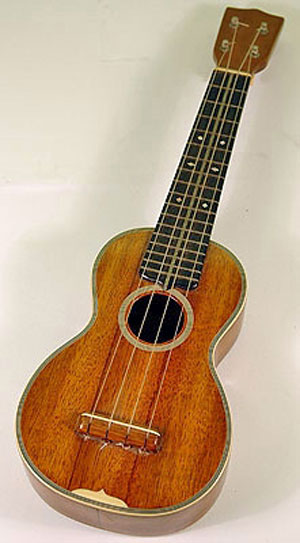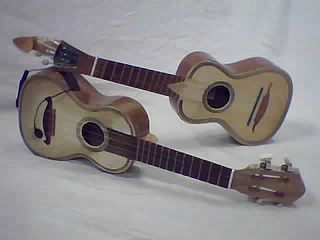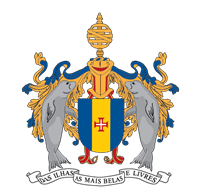
Madeira, officially the Autonomous Region of Madeira, is one of two autonomous regions of Portugal, the other being the Azores. It is an archipelago situated in the North Atlantic Ocean, in a region known as Macaronesia, just under 400 kilometres (250 mi) to the north of the Canary Islands and 520 kilometres (320 mi) west of the Kingdom of Morocco. Madeira is geologically located on the African Tectonic Plate, although it is culturally, politically and ethnically associated with Europe, with its population predominantly descended from original Portuguese settlers. Its population was 251,060 in 2021. The capital of Madeira is Funchal, which is located on the main island's south coast.

The ukulele, also called a uke, is a member of the lute family of instruments of Portuguese origin and popularized in Hawaii. It generally employs four nylon strings.

The xylophone is a musical instrument in the percussion family that consists of wooden bars struck by mallets. Like the glockenspiel, the xylophone essentially consists of a set of tuned wooden keys arranged in the fashion of the keyboard of a piano. Each bar is an idiophone tuned to a pitch of a musical scale, whether pentatonic or heptatonic in the case of many African and Asian instruments, diatonic in many western children's instruments, or chromatic for orchestral use.

Portuguese music includes many different styles and genres, as a result of its history. These can be broadly divided into classical music, traditional/folk music and popular music and all of them have produced internationally successful acts, with the country seeing a recent expansion in musical styles, especially in popular music.

The cavaquinho is a small Portuguese string instrument in the European guitar family, with four wires or gut strings.

The oboe da caccia, also sometimes referred to as an oboe da silva, is a double reed woodwind instrument in the oboe family, pitched a fifth below the oboe and used primarily in the Baroque period of European classical music. It has a curved tube, and in the case of instruments by Eichentopf, a brass bell, unusual for an oboe.

A lithophone is a musical instrument consisting of a rock or pieces of rock which are struck to produce musical notes. Notes may be sounded in combination or in succession (melody). It is an idiophone comparable to instruments such as the glockenspiel, vibraphone, xylophone and marimba.

The tumbi or toombi, also called a tumba or toomba, is a traditional musical instrument from the Punjab region of the northern Indian subcontinent. The high-pitched, single-string plucking instrument is associated with folk music of Punjab and presently very popular in Western Bhangra music.

The bianqing is a traditional Chinese percussion instrument consisting of a set of L-shaped flat stone chimes known as qing, played melodically. The chimes were hung in a wooden frame and struck with a mallet. Along with the bronze bells called bianzhong, they were an important instrument in China's ritual and court music going back to ancient times.

An experimental musical instrument is a musical instrument that modifies or extends an existing instrument or class of instruments, or defines or creates a new class of instrument. Some are created through simple modifications, such as cracked cymbals or metal objects inserted between piano strings in a prepared piano. Some experimental instruments are created from household items like a homemade mute for brass instruments such as bathtub plugs. Other experimental instruments are created from electronic spare parts, or by mixing acoustic instruments with electric components.
Traditional Vietnamese musical instruments are the musical instruments used in the traditional and classical musics of Vietnam. They comprise a wide range of string, wind, and percussion instruments, used by both the Viet majority as well as the nation's ethnic minorities.

The Folklore Museum at Mysore, India, is a museum which exhibits folk art and crafts from all over the state of Karnataka

The Cretan lyra is a Greek pear-shaped, three-stringed bowed musical instrument, central to the traditional music of Crete and other islands in the Dodecanese and the Aegean Archipelago, in Greece. The Cretan lyra is considered to be the most popular surviving form of the medieval Byzantine lyra, an ancestor of most European bowed instruments.
SE, Se, or Sé may refer to:

The Music of Madeira reflects its cultural heritage, this can be seen in the local folklore music, which in Madeira is widespread and mainly uses local musical instruments such as the machete, rajão, brinquinho and cavaquinho, which are used in traditional folkloric dances like the bailinho da Madeira.

The harpsichord-viola is a hybrid musical instrument based on the designs of Leonardo da Vinci on folio 93r of the Codex Atlanticus. It's a different project from the viola organista. It is about the size of a child's toy piano. It weighs 33 pounds and straps to the musician's chest. It's unlike anything else in the orchestra. It has the strings of a violin but is played with a keyboard, and it's powered by the musician's legs as he walks. It's built with the materials that Leonardo would have had on hand, including wooden pegs and gears run by twine. In the folio of Leonardo, you can see that the instrument has a harness. So it was invented as a way to play a stringed instrument while marching. The leg pumps a wooden motor, which moves a long loop of horsehair through the instrument. When the player presses the keys, the strings move up against the loop.

The rajão is a 5-stringed instrument from Madeira, Portugal. The instrument traces back to the country's regional folk music, where it is used in folklore dances of Portugal in addition to other stringed instruments from the same region.

The Legislative Assembly of Madeira is the legislature of the Portuguese autonomous region of Madeira. The last regional election was held on 24 September 2023, won by the PSD/CDS-PP coalition with 58,394 votes.
Branquinho is a diminutive form of Branco. Branco may refer to:

















